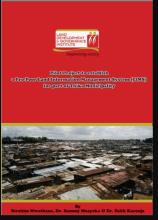/ library resources
Showing items 1 through 9 of 47.The application of computer technology in land administration is touted as one way of ensuring efficient and transparent land administration.
Despite a history of more than 100 years and the introduction of provisional maps to support land registration, the Kenyan cadastre is largely incomplete. It consists of a patchwork of maps of different positional qualities, which would not be readily integrated to create a nation-wide coverage.
Land administration arrangements and practices in any country influence the pace and outcomes of social and economic developments. Since the United Nations adopted the Sustainable Development Goals (SDGs), nations have been encouraged to take initiatives to attain the SDG targets.
Fiscal instruments are tools that governments use to manage revenue and expenditure and therefore influence the growth (or stability) of the various sectors of the economy. Government revenue is derived primarily through taxation.
The acquisition of land by foreigners in developing countries has emerged as a key mechanism for foreign direct investment (FDI).
According to 2001 statistics, 924 million people, almost one third of the world’s population lived in slums. A majority of these people are in the developing countries and they account for 43% of the urban population.
Land plays a vital and central role in the economic, social-cultural and political lives of both individuals and communities.
Land acquisitions, either driven by foreign investments or domestic investment needs have continued to polarize opinions.
Kenya is going through a period of intense transition. The country's main development policy, Vision 2030, is just entering the second Medium Term Plan of Implementation from 2013.
Pagination
Land Library Search
Through our robust search engine, you can search for any item of the over 73,000 highly curated resources in the Land Library.
If you would like to find an overview of what is possible, feel free to peruse the Search Guide.









